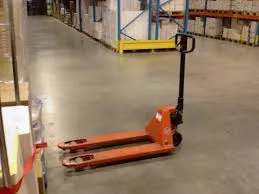


Understanding Manual Pallet Lifters A Comprehensive Guide
Manual pallet lifters, also known as manual pallet jacks, are indispensable tools in various industries, particularly in warehouses, manufacturing plants, and retail environments. Designed to facilitate the movement of heavy loads, these devices are equipped with forks that slide under pallets, enabling operators to lift and transport goods with ease. In this article, we will explore what manual pallet lifters are, their benefits, and how to use them safely and effectively.
What is a Manual Pallet Lifter?
A manual pallet lifter typically consists of a robust frame, two forks for engaging the pallet, and a set of wheels for easy maneuverability. The operator manually pumps a handle to lower or raise the forks, relying on hydraulic mechanics for lifting. While they come in various shapes and sizes, the most common design features a low profile, allowing the forks to access pallets easily, even in tight spaces.
Benefits of Using Manual Pallet Lifters
1. Cost-Effective Manual pallet lifters are generally more affordable than electric or motorized alternatives, making them an appealing option for small to medium-sized businesses looking to optimize their material handling processes without breaking the bank.
2. Simplicity The mechanism of a manual pallet jack is straightforward. With minimal training required, operators can quickly learn to use the device, which increases efficiency in operations.
3. Maneuverability Due to their compact design, manual pallet lifters are highly maneuverable, allowing operators to navigate tight aisles and crowded workspaces with ease.
5. Versatility These devices can handle a variety of pallets and loads, making them suitable for many applications, from moving goods in a warehouse to loading shipments.

Safe Operation of Manual Pallet Lifters
While manual pallet lifters are relatively easy to operate, safety should always be a priority. Here are some essential tips for safe use
1. Inspect Before Use Always check the pallet lifter for any signs of wear and tear, including hydraulic leaks, damaged forks, or malfunctioning wheels. Regular maintenance ensures that the equipment remains in good working condition.
2. Know the Load Capacity Each manual pallet lifter has a specified load capacity. Exceeding this limit can lead to equipment failure or accidents. Always use equipment within its designated capacity.
3. Proper Lifting Technique When using the lifter, ensure that the forks are correctly positioned under the pallet. Pump the handle smoothly to lift the load and maintain a stable posture to prevent back strain.
4. Maintain Visibility When moving a load, ensure that your pathway is clear. If the load obstructs your view, consider walking backward or having a colleague guide you.
5. Be Mindful of Surroundings Always be aware of your surroundings and watch out for obstacles, other workers, or equipment that may hinder your movement.
Conclusion
Manual pallet lifters are a valuable asset in any material handling operation. Their affordability, ease of use, and robustness make them favored tools for transporting goods across various settings. By following safety best practices, operators can maximize their efficiency while minimizing potential hazards. Investing in a quality manual pallet lifter can streamline workflow and improve productivity in any business reliant on warehouse operations. With the right equipment and understanding, you can enhance your material handling processes significantly.



